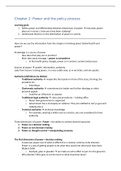Chapter 2: Power and the policy process
Learning goals
1. Define power and differentiate between dimensions of power how does power
play out in issues / cases you have been studying?
2. Understand theories on the distribution of power in society
How can we use the information from the chapter in thinking about Global Health and
power?
Knowledge is a source of power
- How does that play out in practice?
- Main take away message = power is everywhere
o In the health policy triangle, power is in content, context and process
Sources of power wealth, information, authority
Lady from lecture is doing power, in a very subtle way, as in we listen, and she speaks.
Authority (definitions by Weber)
- Traditional authority maybe like the teacher in front of the class, the king, the
president etc.
o Sinterklaas
- Charismatic authority commitment to leader and his/her ideology or other
personal appeal
o Could be an influencer or popstar
- Traditional-legal authority rules and procedures – holding office
o About how government is organized
o Government has a monopoly on violence. They are entitled to carry a gun and
nobody else is
- Technical authority technical knowledge
o For example, wearing a white coat as a doctor, you are considered to have
authority
Three dimensions of power. Power = the ability to achieve desired outcomes
1. Power as a decision making
2. Power as non-decision making
3. Power as thought control = manipulating someone
The first dimension of power = decision making
- A exercises power over B when A affects B in a manner contrary to Bs interests
- Power is a way of getting people to do what they would not otherwise have done
(Robert Dahl)
o Example, glass in glassbin we make an extra effort to put it in the glass bin.
- Who decides? Who gets to cut the knot on what should be done?
, o Always a relevant question to ask
Second dimension of power: non-decision making
- What issues should be issues of policy making?
- Some issues do not reach the policy agenda
- Example: zwarte piet
o Every year there are discussion about it
o This topic wasn’t just raised and put on the agenda, but it was a magazine in
1967 in which it was raised. It took many years to become an issue on the
policy agenda. This is non-decision making.
o Example: not choosing a policy is also a policy
Universal health coverage took many years
In the USA there were parties who had an interest in keeping it a
market issues, who framed the issues as unfavorable
It wasn’t random
It was millions of dollars spend to keep it off the agenda
So many parties benefited from keeping it a market thing (lobbying
groups)
Examples of lobbying groups: pharmaceutical companies, health
professionals, hospitals, health insurance companies etc.
o Thus: it’s about the most powerful, the state, being not inclined to look into
some societal issue.
Third dimension of power = thought control
- Not about parties arguing about should we or should we not act. Some issue is just
not an issue because we think its normal. It’s just the way things are. This is an aspect
of power.
- Example: women do not go to university, marrying means losing autonomy, women
learn how to cook and clean.
o Why do women let their daughters get circumcised, whilst being through it
themselves and it being illegal?
It just the way things are, they believe you are supposed to do it
- ‘Power is most effective and most secure when it becomes so much part of the
background that it is unobserved and internalized.’
Relation of power to health
- Decision-making in psychiatric health is based on DSM-5. But who wrote this book?
- Think about actual cases while reading the book
Some slides are skipped, but still important
Theories that focus on the distribution of power in society
- Pluralism
- Elitism
- Bounded pluralism sub-politics
,Political system by Easton
From the environment, demands and supports go in then its decision making policy
Demands (part of agenda setting, for example more housing for students)
Supports (example, taxes, voting and trust)
Policy is then what are we going to do about the problem and how are we going to
implement it.
Pluralism = equal distribution of power among groups in society (assumption by Dahl)
- Protected by political rights to vote and to free speech (lobbying, demonstration,
strike, free mass media)
- Individual citizens have the right and ability to organize in groups and associations
- State is neutral
- Criticism to pluralism
o State is not neutral
o Interest groups are not equally powerful
o For governments is always easier to talk to groups which are organized, who
have a spokesman. Those who are not organized are often not heard.
o Theory ignores power of non-state actors outside the system, such as,
transnational companies or international organizations
Alternative to pluralism is Elitism
- Assumption = Acknowledges that power is not distributed evenly
- Political elite only open to members of dominant economic classes
- Political decision making is dominated by elites
- Interest groups are not equally powerful due to a lack of resources
- Criticism to elitism
o Overstates capacity of elites to wield power
o Non-elites do challenge elites
o There are multiple groups competing for attention on specific issues
Bounded pluralism
- Distinction between high and low politics
o High politics = maintenance of core values and long-term objectives of state –
systemic or macro policies
, Major economic decisions
Perceived national state security crises
Along with elitism lines
o Low politics = often health policies
Along pluralist lines with participation of different groups
Health is often a subject to processes of subpolitics in a networked
society
Stronger groups (pharmaceutical companies) and weaker groups
(consumer/patient) groups
3. Define a political system and understand how political systems may influence
participation and health policy how does the context of the issues / cases you
have been studying influence the issues’ dynamics?
4. Understand theories of the process of decision making based on the appreciation of
the role of power and rationality
What is a political system?
- State
- Political parties
- Organization outside government; interest groups, NGOs, industry
- Individual voters
Categorization of political systems (by Blondel)
1. Liberal-democratic
2. Egalitarian-authoritarian
3. Traditional-inegalitarian
4. Populist
5. Authoritarian-inegalitarian






